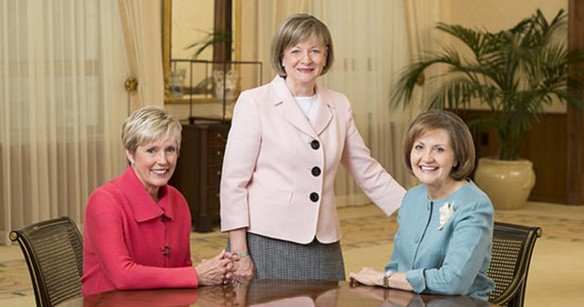
It was during the presidency of Spencer W. Kimball when the leadership of the Church formally aligned themselves with the three-fold mission of the Church:
Proclaim the Gospel
Strengthen the Members
Redeem the Dead
The three presidents of the Church’s organizations headed by women have been invited to be permanent members of the the Executive Councils aligned with this three-fold mission.
The Relief Society General President, Sister Linda K. Burton (right), becomes a permanent member of the renamed Priesthood and Family Executive Council.
The General Young Women’s President, Sister Bonnie L. Oscarson (center), joins the Missionary Executive Council.
The General Primary President, Sister Rosemary Wixom (left), joins the Temple and Family History Executive Council.
The women who have served in these positions have often been ad hoc participants in these councils in the past, but the formalization of their membership in these councils and broadening the focus beyond “priesthood” is highly significant. This move does not merely add three women to the highest Church councils, but serves as an initial step towards integrating tens of thousands of women into Church leadership throughout congregations in all the world.
For those who are not aware, the LDS Church is highly centralized, and so each congregation is organized in a manner consistent with policies from Church headquarters. Thus there will not be debate and schism regarding how women are to be included in what was previously the “Priesthood Executive Council” or PEC that serves as the entity for tactical governance for congregations (“wards” for congregations of ~500, “branches” for congregations where the Church is less-well established, often numbering ~100) and groupings of congregations (“stakes” for groups of wards, “districts” for groups of branches).
With the announcement that the highest “PEC” in the LDS Church is becoming the “PFEC,” with permanent inclusion of women, we can expect an updated version of the Handbook of Instructions that rolls out and dictates the PFEC structure for stakes, wards, districts, and branches. Women in the congregations (who are already in positions of leadership) will become part of the PFEC.
For those parts of the world where a single family was already the “congregation,” governance by both the male and female leader of the “congregation” has already been the pattern for tactical governance.
[Feel free to point out where I might have erred in my understanding of what’s going on here.]